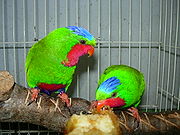
Blue-crowned Lorikeet
Encyclopedia

Parrot
Parrots, also known as psittacines , are birds of the roughly 372 species in 86 genera that make up the order Psittaciformes, found in most tropical and subtropical regions. The order is subdivided into three families: the Psittacidae , the Cacatuidae and the Strigopidae...
found throughout the Samoa and Tonga islands and Lau archipelago, including: ʻAlofi
Alofi
Alofi is the capital city of the Pacific Ocean nation of Niue. With a population of 581 , Alofi has the distinction of being the smallest national capital city in terms of population. It consists of the two villages Alofi North and Alofi South, where the government headquarters are located. Alofi...
, Fotuhaʻa
Fotuha'a
Fotuha'a is an island in Lifuka district, in the Haªapai islands of Tonga. It had a population of 132 and an area of 1.14 km²....
, Fulago, Futuna, Haʻafeva, Niuafoʻou
Niuafo'ou
Niuafoou is the most northerly island in the kingdom of Tonga. It is a volcanic rim island of 15 km² and with a population of 650 in 2006.-Geography:...
, Moce, Niuē
Niue
Niue , is an island country in the South Pacific Ocean. It is commonly known as the "Rock of Polynesia", and inhabitants of the island call it "the Rock" for short. Niue is northeast of New Zealand in a triangle between Tonga to the southwest, the Samoas to the northwest, and the Cook Islands to...
, Ofu
Ofu
Ofu may refer to*Ofu , an island and its village in Vava'u in Tonga*Ofu-Olosega, an island in the Manu'a group in American Samoa*Ofu, Nigeria, a town and Local Government Area in Kogi State...
, Olosega, Sāmoa
Samoa
Samoa , officially the Independent State of Samoa, formerly known as Western Samoa is a country encompassing the western part of the Samoan Islands in the South Pacific Ocean. It became independent from New Zealand in 1962. The two main islands of Samoa are Upolu and one of the biggest islands in...
, Savaiʻi
Savai'i
Savaii is the largest and highest island in Samoa and the Samoa Islands chain. It is also the biggest landmass in Polynesia outside Hawaii and New Zealand. The island of Savai'i is also referred to by Samoans as Salafai, a classical Samoan term used in oratory and prose...
, Tafahi
Tafahi
Tafahi is a small island in the north of the Tonga archipelago, in fact closer to Savaii than the main islands of Tonga. It is only north-northeast away from Niuatoputapu, and fishermen communicate in small outboard motorboats almost daily between the two.Other names for Tafahi are Cocos Eylant ...
, Taʻu
Tau
Tau is the 19th letter of the Greek alphabet. In the system of Greek numerals it has a value of 300.The name in English is pronounced , but in modern Greek it is...
, Tofua
Tofua
Tofua Caldera, in Tonga, is the summit caldera of a steep-sided composite cone that forms Tofua Island. Tofua Island is in Tonga's Ha'apai island group. Pre-caldera activity is recorded by a sequence of pyroclastic deposits and lavas constituting the older cone, followed on the northern part of the...
, Tonga
Tonga
Tonga, officially the Kingdom of Tonga , is a state and an archipelago in the South Pacific Ocean, comprising 176 islands scattered over of ocean in the South Pacific...
, Tungua
Tungua
Tungua is an island in Lulunga district, in the Ha'apai islands of Tonga....
, ʻUiha
'Uiha
Uiha is an island in Lifuka district, in the Haapai islands of Tonga. It had a population of 638 and an area of 5.36 km².More about Ha'apai at http://www.nelligennet.com/horst.com...
, ʻUpolu, Varoa, Vavaʻu
Vava'u
Vavau is an island chain of one large island and 40 smaller ones in Tonga. According to tradition Maui fished both Tongatapu and Vavau but put a little more effort into the former. Vavau rises 204 meters above sea level...
, and Voleva. It is a 19 cm green lorikeet with a red throat, blue crown, and belly patch shading from red at the top to purple at the bottom.
It is still common, but declining on some islands, apparently from predation by rats. They frequent areas with flowering trees, including coconut plantations and gardens, usually in small flocks of less than about 15 individuals or in pairs during breeding season. It eats nectar, pollen, and soft fruits, especially wild hibiscus and coconut. The blue-crowned lorikeet nests in holes in trees, but may also dig burrows in earth banks.
Also known as:
- Blue-crowned Lory
- Blue-crested Lory
- Solomon Lory
- Samoan Lory
- Segavao (Samoa)
- Henga (Tonga)

